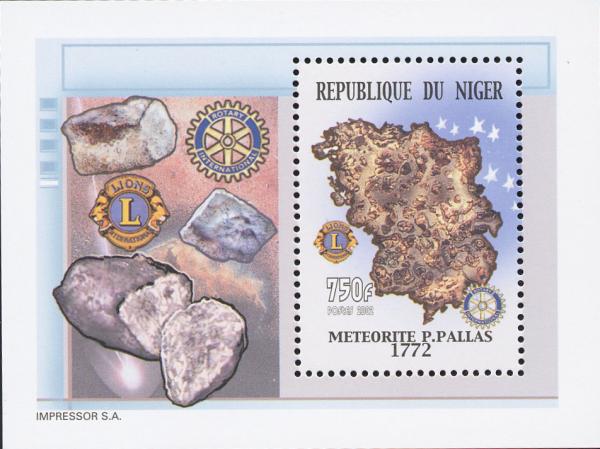the Pallas meteorite

Stato: Niger Anno: 2002 Notizie: The first stamp depicts the Pallas meteorite, commonly known as Krasnojarsk among meteorite collectors. The Pallas meteorite is sometimes called the "foundation stone" of meteoritics since analysis of its chemical composition afforded a basis for those claiming meteorites had an extraterrestrial origin. The Pallas stone was found by a retired Cossack named Yakov Medvedev around 1749. Around 1771 or 1772 the stone came to the attention of the naturalist Pyotr Simon Pallas. Pallas, after whom the stone would later be named, was a German who conducted a wide spectrum of scientific investigations in Siberia under the aegis of the Tsar's Academy of Sciences in St. Petersburg. At that most academics dismissed the idea of stones falling from the sky, and Pallas was no different, although he recognized that the Pallas stone was definitely something unusual. Samples of the strange stone were sent to labs all over Europe. In 1776 the German chemist E. K. F. Meyer performed a chemical analysis of a sample of the Pallas stone and showed that it could not have had a human or volcanic origin. In 1794 Ernst Chladni, a German physicist, listed the Pallas stone as an example of a stone with an extraterrestrial origin. However, it was the English chemist Edward Howard and his French colleague Jacques-Louis Compte de Bournon who in 1802 first showed the basic similarities in composition among several different meteorites from different locations, including the Pallas stone. All of the meteorites contained nickel, not an element typically found in terrestrial rocks. The analyses of Howard and Compte de Bournon, among others, helped convince most scientists that stones really did fall from the sky, and that they did not originate on Earth. Meteorites with a composition similar to the Pallas stone are now called "Pallasites." Pallasites are composed of olivine crystals set in a nickel-iron matrix. They probably formed in the boundary layer between the iron core and the stony mantle of an asteroid. Thin translucent slices of well-preserved Pallasites are very attractive and are used to create jewelry. Roy A. Gallant provides an in-depth look at the importance of the Pallas stone in his article A Man Named Bear and His Meteorite: The Fall and Rise of the Pallas Nugget . |
|---|